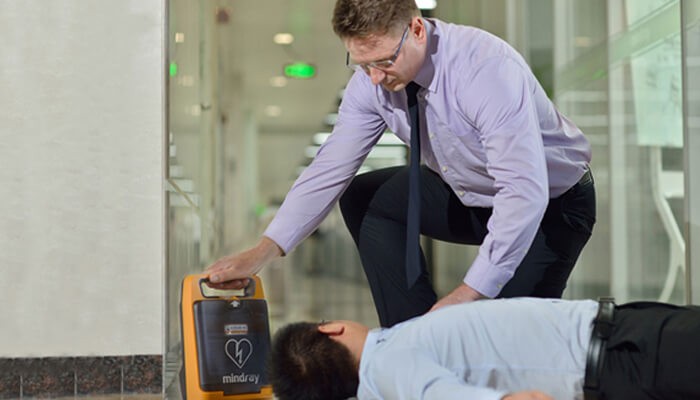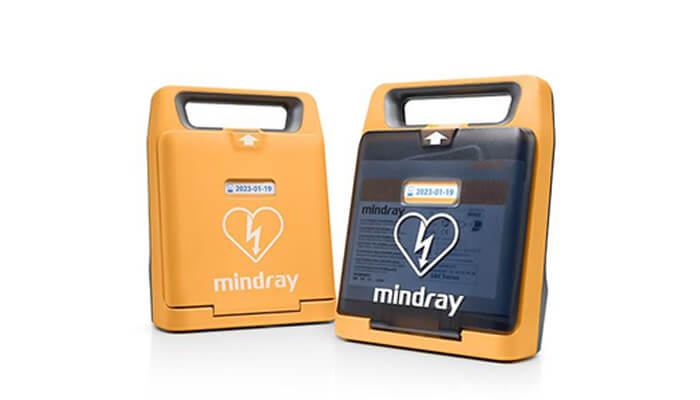People usually mix up a heart attack with a cardiac arrest. Both are life-threatening cardiac emergencies, but they are not the same. A heart attack is a blockage in the blood circulation to the heart. The other is a sudden disorder in cardiac electrical activity, leading to a dangerously irregular heart rhythm that can stop the heart from beating. In both situations, an automated external defibrillator (AED) is a great life-saving option for people with severe heart diseases.
However, it can only deliver electric shocks with a certain kind of irregular heart rhythm. Wondering if you can use AED in first aid for both cases? This article will discuss heart attack and cardiac arrest in detail to discover the relationship between them and when you should use AED.
What are heart attacks and cardiac arrests?
A heart attack is a sign of a blocked artery preventing oxygenated blood flow to a segment of heart tissue. The affected part begins to necrotize, and the infarct area grows if rapid and adequate treatment is not provided.
Sudden Cardiac Arrest (SCA) occurs by an abrupt electrical disturbance in the cardiac rhythm without warning. It results in arrhythmia and disrupts blood flow toward vital organs like the brain, lungs, and others. A person becomes unconscious in a few seconds and has no pulse or breath.
The two heart conditions are related to each other. There is a chance of an SCA after a heart attack or during recovery from damage. However, a heart attack does not always cause an SCA. But it is a common cause that increases the risk of sudden cardiac arrest.
Following are the common differences between these two types of illnesses.
1. Causes
A heart attack is a warning sign of impaired blood flow to the cardiac tissue, and SCA occurs due to a disturbance in the electrical rhythm. Other heart problems like heart failure, and arrhythmias, particularly ventricular fibrillation, may also disrupt the heart’s rhythm, leading to an SCA.
2. Duration
A heart attack usually progresses slowly and can last for hours, days, or weeks. Symptoms of a heart attack may be intense and immediate, or they may start slowly and last longer before the attack. Alternatively, cardiac arrest is a sudden attack with no warning and can cause a patient to die in a short time.
3. Heartbeat
A heartbeat is still present during a heart attack, but there is no heartbeat during cardiac arrest. You will only hear a gasping sound for a few seconds in a patient with SCA.
How to Differentiate a Normal Cardiac Patient and an SCA Patient at the Scene
- It is a cardiac arrest if the patient suddenly loses consciousness, has no heartbeat, and has abnormal or no breathing. Sometimes, SCA victims experience only abnormal gasping and 10-20 seconds of seizures at the onset. The SCA victim is always unconscious and will die within minutes if immediate intervention is not provided.
- It is a heart attack if the patient feels chest tightness, fainting, dizziness, and shortness of breath. The person is conscious and may complain of some signs and symptoms of a heart attack.
In addition, the automatic ECG analysis when using an AED in first aid determines if the patient is in cardiac arrest and whether an electric shock treatment can be helpful. If the patient is not in sudden cardiac arrest, the AED will not deliver an electric shock to defibrillate him or her. Therefore, inexperienced rescuers can confidently administer AED even when they cannot tell the patient is in cardiac arrest or heart attack.
How to Resuscitate People Suffering from a Heart Attack and Cardiac Arrest
Here is a short guide to resuscitating if a person gets a heart attack or SCA. Remember that your fast and correct action can save someone’s life.
Heart Attack
- First, call for emergency services and an ambulance.
- Ask the patient if they carry around some medicine with them. Quickly find out and assist them in taking it.
- Help the patient relax, lie down and remain calm.
- Tell them to avoid eating or drinking to prevent vomiting or aspiration.
- If the victim is awake, do not apply chest compressions or perform CPR, and do not use an AED in first aid.
Sudden Cardiac Arrest
- Quickly call for emergency medical service and an ambulance at the site.
- Use an AED in first aid as soon as possible to restore cardiac rhythm.
- Immediately perform CPR.
Consider Mindray AED for Effective Resuscitation
AED in first aid offers a great way to save someone’s life. Mindray — a reputed AED brand— is designed for first-time rescuers and trained experts. Mindray AEDs help them with effective SCA resuscitation and confidence in using an AED in first aid. Their popular products include remote AED management solutions, semi-/fully automated AED equipment, and others to meet advanced healthcare needs.
Their innovative AED solutions are specialized enough to save SCA victims’ lives effectively. Untrained rescuers can easily follow the guides from Mindray AEDs, and the AEDs will decide whether shock treatment is required without harming victims who still have a heartbeat. For more information, visit Mindray’s website and contact them to build your fleet of AED!




